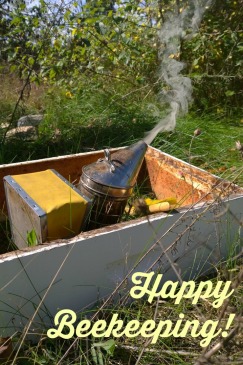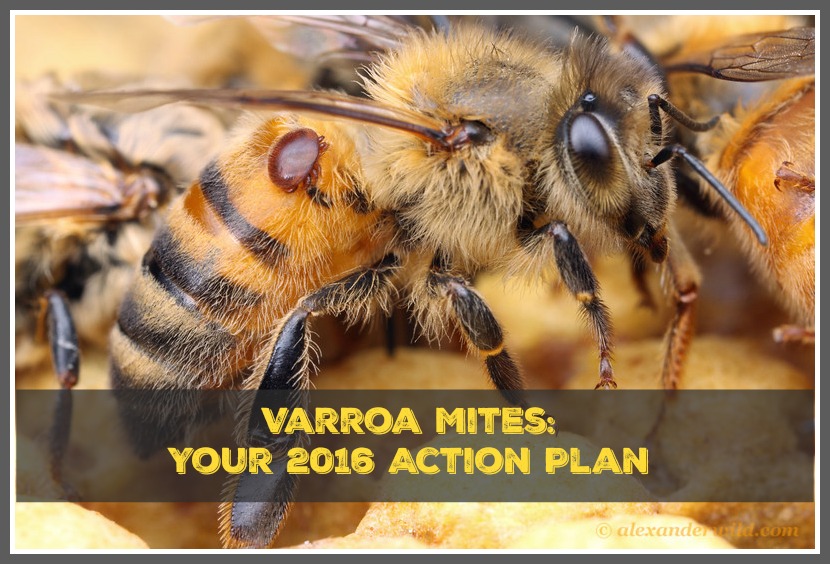February in the midwest is rough. I’m a school teacher, so I’m now quite removed from Christmas break, but still far from spring break. The weather is dark, cold and (usually) snowy. By March it feels like spring is on the horizon, but February feels like a cavernous hole of cold that will never let up. It’s especially hard on beekeepers for a few reasons: (1) by now you might be mourning the loss of a hive or two, (2) if you’re not, you’re hoping they’re still alive, (3) if they ARE still alive, there’s nothing you can really do, but just think about them.
This is why I was so excited to attend (and present at) the Kalamazoo Bee School last Saturday. It was a great chance to learn, think, and talk about bees with other local keepers. I especially love to connect with new beekeepers because their excitement and anxiety is kind of exhilarating!
I went to two sessions about varroa mites (one by Ali Leist and one by Meghan Milbrath) and decided to outline some of the new recommendations regarding varroa management. This will give you something to think and read about until you can actually get outside and check on those bees!
Basically, if you live in any of the countries in red, you have varroa mites in your hive. They might not exist in debilitating numbers, but they’re there.
As a quick review, the varroa gets inside the cell with the larvae just before the adult bees cap it. Then, once capped, the mite is free to feed on the larvae and reproduce at its leisure. This is important to know because (1) it means our bees are beginning their lives already weakened in one manner or another and (2) eradicating mites is much trickier than fighting a problem that affects only adult bees.
So what can we do about it? Well I’m going to outline a 3-prong approach that both Ali and Meghan recommended based on the newest research:
1. Monitor and Record
It’s hard to really evaluate the health of a hive if you don’t know what’s going on inside of it, therefore, add monitoring for mites to your monthly to-do list. You can do the sugar shake method (quick, easy, and cheap) or the alcohol wash (also quick, easy, and cheap and more accurate, but it does kill some bees). Most people use the sugar shake and you can buy a kit from Cathy King (in the SW Michigan area), you can order one online, or you can make your own pretty easily.
Here’s an overview of the sugar shake method from the Michigan Beekeepers Association. Each month, record the mite numbers in your hives (or a sampling of hives if you have more than 10), so you can treat if needed. You can even submit your results and be your very own citizen scientist!
How many mites are too many mites? According to Milbrath, the threshold for what is acceptable has been lowered, as the problem with mites continues to escalate. The current threshold is 3 mites per 100. More than that, and you need to treat.
2. Treat When Necessary
When Meghan spoke, she urged beekeepers to treat in the spring and fall. If you do nothing else, you can at least do this. Remember, beekeeping is not a hobby that exists in a vacuum. You are managing a wild creature that goes out into the world and interacts with other bees. It’s all well and good if you don’t care about mites, but your bees are then spreading mites to other colonies. The only way we, as a whole, are going to get a handle on varroa is if we, as beekeepers, all work together.
Something else to consider is that today’s treatments are MUCH better and much safer than treatments of old. Many of the options are acid-based, which means residue won’t accumulate in the comb. I’m a parent, so I think of treating the same way I think about medicating my children. I don’t like to use medicine unnecessarily, but I also won’t allow my children to suffer. As a parent you must always weigh these things and as a responsible beekeeper (or cattle farmer, or horse, dog, or cat owner) you must do the same. Yes, you are adding a substance to your hive, but people add sugar water and Honey B Healthy all day long and there’s no controversy there! Anything you do is going to have SOME impact, so do your research and make the best choice.
There are four treatments that were recommended on Saturday. Keep in mind varroa excels at building immunity, so you want to vary your treatment. Use one in the spring and a different one in the fall, for example. Below is an overview of the four organic mite treatments from MaineBeekeepers.org
ApiLifeVar
active ingredients: thymol, eucalyptol, menthol, camphor
ApiLifeVar is a contact/vapor action pesticide formulated on a vermiculite tablet. It is considered to be an organic pesticide and is dependent on optimum temperatures. It requires three successive applications when bees are not making honey and supers are not on hives. This pesticide can cause adverse effects to hives in a weakened state.
 Apiguard
Apiguard
active ingredient: thymol
Apiguard is a contact/vapor action pesticide formulated as a gel. It is also considered to be an organic Varroa control and is effective in controlling Varroa under optimal conditions, like ApiLifeVar. The product is only effective within a limited temperature range when bees are not making honey and without supers in place. Apiguard can cause bee mortality if used in high temperatures and may incite robbing behavior to hives undergoing treatment.
 Mite-Away Quick Strips
Mite-Away Quick Strips
active ingredient: formic acid
Mite-Away Quick Strips is an organic vapor-action pesticide formulated in a pre-soaked pad. This product is effective within a certain temperature range and can be hazardous to the applicator. The MAQS can be used while bees are making honey with supers on colonies. This pesticide is associated with queen loss, adult bee and brood mortality, and absconding when used during hot temperatures. The product’s efficacy is inconsistent and influenced by the amount of brood present and size of the hive being treated.
 Hopguard
Hopguard
active ingredient: beta acids
Hopguard is authorized under EPA-FIFRA Section 18 Emergency Exemption. It is an organic pesticide formulated on a cardboard strip. The product may be used while bees are making honey and supers are in place. It performs well in hives with minimal-to-no brood and provides control for approximately three days (while strips are wet). The current formulation necessitates multiple applications when hives are actively rearing brood. The manufacturer is currently developing an improved delivery that will provide control for 10 – 14 days. In 2012, Hopguard applications in Maine during cold temperatures resulted in some adult bee mortality due to continual contact with clustered bees. This situation also occurred with CheckMite applications during cold temperatures while bees were clustered.
3. Breeding
In terms of breeding, there are amazing things being done by people much smarter than I to breed for bees with more hygienic and/or aggressive mite-fighting traits. You can research ankle-biter bees or Varroa Sensitive Hygiene (VSH) behavior and spend hours reading and watching videos about these amazing bees. Hopefully, this is our future, but we need to help the bees fight the mites in the meantime! Last year Meghan had queens with ankle-biting traits for sale through the Michigan Pollinator Initiative. Keep an eye on that page this spring for more information.
So, your homework? Create a mite plan now and enjoy healthier bees later!

And follow my beekeeping adventures at MyAdventuresInBeekeeping.wordpress.com


Andrea – Wow! ! ! I have to start by saying I have had limited success as a beekeeper – but that was perhaps 10 years ago. I have the equipment but have to honestly tell myself I don’t have the “passion” to have hives. But I have been on the sidelines and watched. and you have done a great job of outlining the options! Thanks for taking the time and effort!
I’m unsure if this is up for “casual” review, but it sounds like you have done some great research and I want to recognize your efforts.
Eric
Thank you so much for reading and for the kind comments!
So for spring treatment are the MAQs best? I’m thinking about brood starting and honey stores that may still be on.
That was the spring approach recommended at the conference.